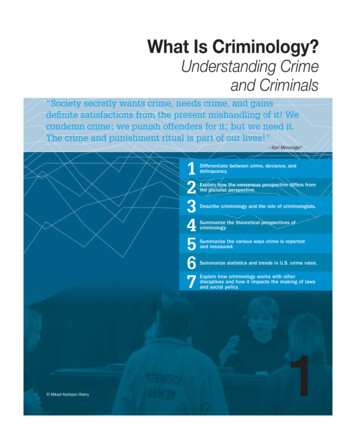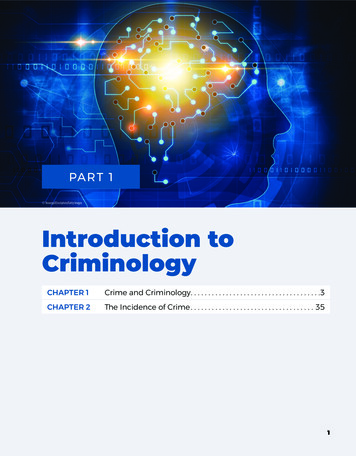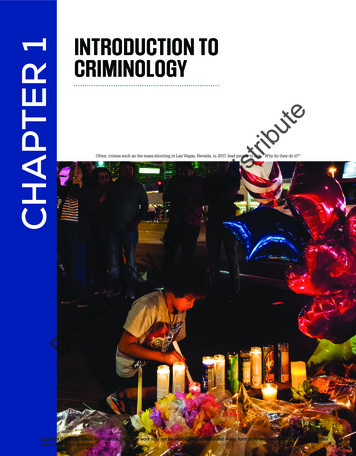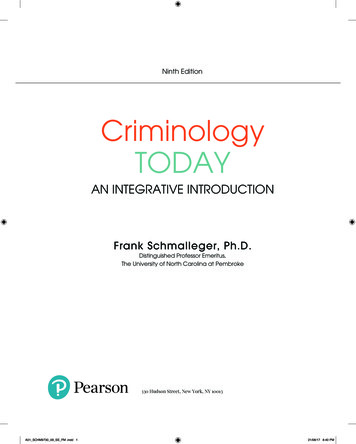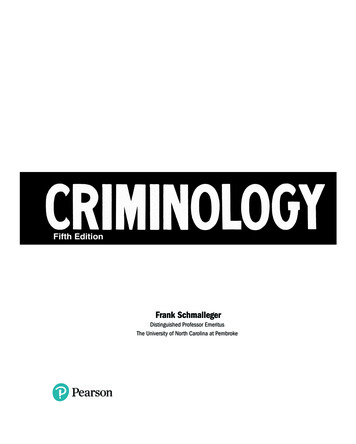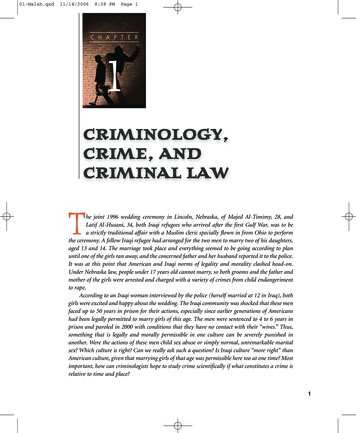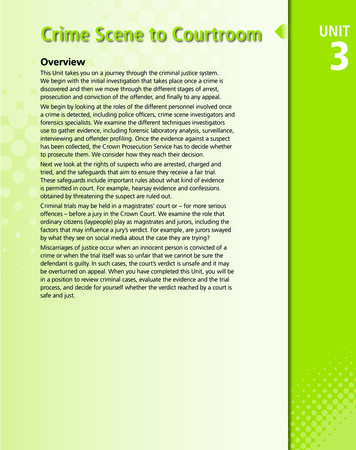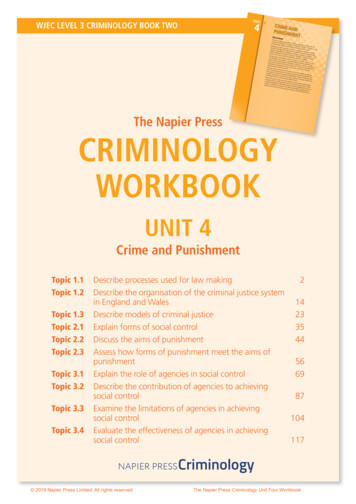
Transcription
UNITWJEC LEVEL 3 CRIMINOLOGY BOOK TWO4CRIMEANPUNISH DMENTOverviewThis Unit is about socialcontrolcontrolour beh– that is,aviourcriminaand ensabout howl justiceure thasystemsocietyt we obeWe begand itsseeksy the lawin by looeffortsto achievking at. It focuse todecisiohow thens of jude socialges. Welaw is macontrol. s on thesystemthen gois organide by Paron to exased toliamentinvolvesuphmine howand bylookingold thetheat howlaw andServicethe crim, the couagenciespunishinal justicethose whrts, prissuch asWe alsoons andthe polo breaklook atice, Croprobationit. Thisthe diffcan bewnserviceerent valbasfit togeth Prosecutionues onrights of ed. For examper.whichle,the acca criminaused aga it can emphathat youl justicesise theinst theare innsystemneed toocepowerthe pubof thelic by sup nt until provenstate, suc protect thepeoplepreh asbeing wro ssing crime, guilty. Or it caneven atfocus on the principlengly conNext wethe cosvicted.protectinglook att of sompunishmeaim ofe innoceimprisont andntnmentwhthe streat it is for.just beets? Orto protecFor exashostraighmple, shot thet’ and lea uld it be abouldut rehabi public by takd a crimpunishmeing offend thelitatinge-free lifent to trycrimina? As weto achievls so tha ers offBut doshall seee severathe prist they ‘go, the jusons, poll differeactuallytice sysnt aims.ice andsucceedtem useother agenciin achieviin prevensesng theirting peoaims? For of the criminaple re-owill bel justin affenexaachieving position to eva ding? When you mple, does pris ice systemluate howsocial conon succeehave comeffectivtrol ande the diff pleted this Un densurinit, youereg that society’s me nt agencies arembers obeiny the law.86The Napier Press86-169NapierCriminology 2.indd 1CRIMINOLOGYWORKBOOKUNIT 4Crime and PunishmentTopic 1.1 Describe processes used for law making 2Topic 1.2 Describe the organisation of the criminal justice systemin England and Wales 14Topic 1.3 Describe models of criminal justice 23Topic 2.1 Explain forms of social control 35Topic 2.2 Discuss the aims of punishment 44Topic 2.3 Assess how forms of punishment meet the aims ofpunishment 56Topic 3.1 Explain the role of agencies in social control 69Topic 3.2 Describe the contribution of agencies to achievingsocial control 87Topic 3.3 Examine the limitations of agencies in achievingsocial control 104Topic 3.4 Evaluate the effectiveness of agencies in achievingsocial control 117NAPIER PRESS 2019 Napier Press Limited. All rights reserved CriminologyThe Napier Press Criminology Unit Four Workbook5/13/1911:59 AMThis Topicthe law deals with wh:o makesththese twoso the gover the jud nmenticiary.We shall look ateach ofGovernmParliament procentessThe United Kingdom isare madea parliamentary‘statutes’ by passing Actdes of Paror ‘legislaliamenttion’.Parliam. Laent is the mo made up of threenarch (theparts: the Hoqueenor king)use ofLords the House ofCommThe moons.narch hasAssentonly a for– theirmaagreement to the l role in law-mnew lawThe Lo.rdsMembersofthepeers weHore noblem use of Lordspasseden(such as are called peefrom fatrsdukher toalso 26eldest son es and barChurchonsofwho can. Honot pas England bishop wever, todays their‘doubles and arcpositiocheck’hbishon on toon newtheir chilaws.ldre
TOPIC 1.1 Describe processes used for law makingDescribe processes used forlaw makingGetting startedWorking with a partner, complete the following:After studying this Topic, you should be able to:- Describe processes used for law making including: government processes judicial processes.TOPIC1.11. From what you have studied so far in your course or from your ownknowledge, note down what you know about how laws are made.For example, who is involved in making the law?2. Consider the law to make stalking a criminal offence (see CriminologyBook One, page 160). Who campaigned for the new law and why didthe campaign succeed?Share your answers with the rest of the class.This Topic deals with who makes the law. In England and Wales, there are two main sources ofthe law: the governmentthe judiciary.We shall look at each of these two sources and how they make the law.Topic 1.1Learning Objectives:Government processes of law makingParliamentThe United Kingdom is a parliamentary democracy. This means that most of the country’s lawsare made by passing Acts of Parliament. Laws made by Parliament are also often referred to as‘statutes’ or ‘legislation’.Parliament is made up of three parts: the monarch (the queen or king)the House of Lordsthe House of Commons.The monarch has only a formal role in law-making. The king or queen simply gives the RoyalAssent – their agreement to the new law.The LordsMembers of the House of Lords are called peers. There are about 800 peers. In the past, allpeers were noblemen (such as dukes and barons) and they were hereditary positions thatpassed from father to eldest son. However, today there are only 92 hereditary peers; there arealso 26 Church of England bishops and archbishops. The rest of the members are life peerswho cannot pass their position on to their children. The main job of the Lords is to act as a‘double check’ on new laws.87Synoptic links: You should relate this to the review of verdicts in criminalcases in Unit 3 and campaigns and changes in policy learned in Unit 1.86-169 Napier Criminology 2.indd 2Getting Started (page 87)Write your answers to the Getting Started activity here.1. From what you have studied so far on your course or from your own knowledge, note downwhat you know about how laws are made. For example, who is involved in making the law?5/13/19 11:59 AMDescribe processes used for law making- Know the legislative process and the role of judges in makingcriminal law.2. Consider the law to make stalking a criminal offence (see Criminology Book One, page 160).Who campaigned for the new law and why did the campaign succeed?1. How does a parliamentary democracy like the UK make most of its laws?2. What is the role of the monarch in law-making in the UK?CriminologyParliament (page 87)NAPIER PRESSGovernment processes of law making (pages 87-90) 2 2019 Napier Press Limited. All rights reserved The Napier Press Criminology Unit Four Workbook
Topic 1.1The Lords (page 87)1. How many peers are there in the House of Lords?3. What is the main job of the Lords in law-making?The Commons (page 88)1. Why is the House of Commons the most important part of Parliament?Describe processes used for law making2. In the UK today, how many hereditary peers are there? How does this compare to in the past?2. How do the 650 Members of Parliament gain their place in the House of Commons?1. What is the presenter trying to show when he pretends to be a dictator?NAPIER PRESSActivity: Media Parliamentary democracy (page 88)Criminology2. What does democracy mean?3. Who gets to vote in the UK?3 2019 Napier Press Limited. All rights reserved The Napier Press Criminology Unit Four Workbook
Topic 1.14. What are the three parts of Parliament?6. Briefly describe the House of Commons and how it is elected.7. How does the House of Lords differ from the House of Commons?Describe processes used for law making5. What are the House of Commons and the House of Lords responsible for?8. What is the Government?NAPIER PRESS9. What is the Cabinet?11. According to the presenter, why is Parliament so important?Criminology10. What is Parliament’s role in relation to the Government?4 2019 Napier Press Limited. All rights reserved The Napier Press Criminology Unit Four Workbook
Topic 1.1The government (page 88)1. What is the government’s job?Describe processes used for law making2. Who gets to form the government?3. Who has to agree a Bill for it to become law?4. What is a ‘Green Paper’?5. What is a ‘White Paper’?The parliamentary stages of a Bill (page 89)Summarise each of the stages a Bill must go through to become a law:1. first reading2. second readingNAPIER PRESS3. the committee stage4. the report stageCriminology5. third reading6. the Lords7. Royal Assent.5 2019 Napier Press Limited. All rights reserved The Napier Press Criminology Unit Four Workbook
Topic 1.1Activity: Media How laws are made (page 89)1. What is the first process in creating a law?2. What are the two types of Bill?4. Why are Government Bills likely to take priority and to be passed by Parliament?5. Briefly explain what happens in the consultation stage.Describe processes used for law making3. Briefly explain the difference between Government Bills and Private Member’s Bills.6. Using the example of twenty-four hour drinking, who would be consulted about the proposedBill?NAPIER PRESS7. What is a Green Paper?9. Why is the Second Reading of a Bill more important? What happens at this reading?Criminology8. What is the purpose of the First Reading of the Bill?6 2019 Napier Press Limited. All rights reserved The Napier Press Criminology Unit Four Workbook
Topic 1.110.What happens at the Committee Stage?12.What happens in the Third Reading and where does the Bill go after that stage?13.How does the Committee Stage in the House of Lords differ from that in the House ofCommons?Describe processes used for law making11.What is the Report Stage?14.What has to happen to a Bill if the Lords make changes to it?17.Briefly outline the example of a Government Bill that was blocked by the House of Commons.Criminology16.Why should the Monarch agree a Bill that is passed to them?NAPIER PRESS15.What happens to a Bill once both the House of Commons and the House of Lords have agreedon it?7 2019 Napier Press Limited. All rights reserved The Napier Press Criminology Unit Four Workbook
Summarise the following criminal laws introduced by government:1. The Criminal Justice Act (2003)3. The Dangerous Dogs Act (1991)Judicial processes of law making (pages 90-91) Describe processes used for law making2. The Crime (Sentences) Act (1997)Topic 1.1Box Some examples of criminal statutes (page 90)Judicial precedent (page 90)1. What is ‘judicial precedent’?2. What is ‘judicial precedent’ based on?Criminology4. Why is the term ‘common law’ used?NAPIER PRESS3. What is the advantage of treating similar cases in the same way?The court hierarchy (page 90)Summarise the court hierarchy in the UK.8 2019 Napier Press Limited. All rights reserved The Napier Press Criminology Unit Four Workbook
1. Summarise the two main situations where a court does not have to follow precedent:a. distinguishing2. Use the example of marital rape to explain why a court might overrule a precedent.Statutory interpretation (page 91)Give examples of the three main interpretation rules used by judges:a. the literal ruleDescribe processes used for law makingb. overruling.Topic 1.1Exceptions to precedent (pages 90-91)b. the golden ruleNAPIER PRESSc. the mischief rule.CriminologyActivity: Media Statutory interpretation (page 91)1. What is the literal rule?9 2019 Napier Press Limited. All rights reserved The Napier Press Criminology Unit Four Workbook
Topic 1.12. What are the advantages and disadvantages of this rule?Describe processes used for law making3. What was Cheeseman caught doing?4. Why was Cheeseman let off?5. What happened to Berriman?6. Why did his family fail to get compensation?8. What did the court consider in this case and why did that mean the appellant was not guilty?Criminology9. What is the golden rule? What is the narrow approach and the wide approach?NAPIER PRESS7. In Whitely v Chappel, what had the appellant done?10 2019 Napier Press Limited. All rights reserved The Napier Press Criminology Unit Four Workbook
12. In Adler v George, what was the importance of the phrase ‘in the vicinity of’?Describe processes used for law making11.Explain the case of R v Allen, which shows the narrow approach to the golden rule. Why didthe court have to decide on the second definition of marriage?Topic 1.110.What are the advantages and disadvantages of the golden rule?13. Why did the court ‘re-write’ the Act of Parliament in the Sigsworth case?NAPIER PRESS14.What is the mischief rule?Criminology15.What are the advantages and disadvantages of the mischief rule?11 2019 Napier Press Limited. All rights reserved The Napier Press Criminology Unit Four Workbook
18.What is the purposive approach?19.What are the advantages and disadvantages of the purposive approach?Describe processes used for law making17.What were the nurses trying to determine in their case against the DHSS in 1981?Topic 1.116.How was the mischief rule used in the cases of Corkery v Carpenter and Smith v Hughes?20.How did the purposive approach help the case of Jones?NAPIER PRESS21.Why was Smith denied access to his natural mother?Criminology22.How was the purposive approach used in the case of R (Quintavalle) v Secretary of State forHealth?12 2019 Napier Press Limited. All rights reserved The Napier Press Criminology Unit Four Workbook
Topic 1.1Preparing for the exam (page 92)Revise Topic 1.1 from your notes and textbook (pages 87-91), then answer the question below.When you have written your answer, compare it with the answer by Sophie on page 92 of yourtextbook and add in any extra points you feel are relevant.Describe the process by which the government makes laws. (9 marks)Describe processes used for law makingNAPIER PRESSCriminologyContinue on a separate sheet if necessary. 2019 Napier Press Limited. All rights reserved The Napier Press Criminology Unit Four Workbook13
Describe the organisation of thecriminal justice system in Englandand WalesTOPICGetting startedWorking with a partner, complete the following:Learning Objectives:1. Using Unit 3 Topic 1.1, write a brief summary of the role of the policein the criminal justice system.2. Using Unit 3 Topic 2.2, write a brief summary of the stages of the trialprocess, including the roles of the personnel involved.You will find that what you learned in Unit 3 about the different stages of the trial process andthe agencies involved, such as the police, CPS and courts, is relevant to this Topic.Overview of the criminal justice systemThe criminal justice system in England and Wales is made up of a number of interconnectedorganisations and agencies. As a starting point, we can divide the system into the followingmain parts: law creation and administration: the passing of the criminal laws by Parliament and therunning of the justice system by government departments law enforcement by the policethe courts (including prosecution and defence) decide the outcome of criminal casespunishment of convicted offenders by the prisons and probation service.From this overview of the system, we can now look in a little more detail at its parts and howthey work. We shall do this by taking a journey through the system, from the creation of criminallaws through to the punishment of offenders.The main agencies of the criminal justice systemLaw creationAs we saw in Topic 1.1, Parliament and judges make the laws dealing with crime. Parliament passes Acts (legislation or statute law).Judges create law by setting judicial precedents that other courts then must follow, and byinterpreting the meaning of statutes (statutory interpretation).Administration of the system Two government departments oversee most of the justicesystem and are responsible for its smooth running: the Ministry of Justice and the Home Office.The policeThe police are responsible for enforcing the criminal law. They investigate crimes, collectevidence, and arrest, detain and question suspects. In minor cases, they may issue a caution86-169 Napier Criminology 2.indd 8935/13/19 11:59 AM- Know the organisation and role of the agencies involved in criminal justice and consider therelationships between different agencies and the extent of co-operation that exists.Synoptic links: You should draw on your learning in Unit 3 regarding the process taken to obtainverdicts in criminal cases and the roles of different personnel and agencies involved. You can alsodraw on your learning of campaigns and changes in policy learned in Unit 1.Getting Started (page 93)1. Using Unit 3 Topic 1.1, write a brief summary of the role of the police in the criminal justicesystem.Describe the organisation of the justice systemAfter studying this Topic, you should be able to:- Describe the organisation of the criminal justice system in Englandand Wales including: police law creation courts formal punishment relationships.Topic 1.2TOPIC 1.2 D escribe the organisation of the criminal justicesystem in England and Wales1.22. Using Unit 3 Topic 2.2, write a brief summary of the stages of the trial process, including theroles of the personnel involved.NAPIER PRESSBriefly outline the four main parts of the criminal justice system in England and Wales.a.b.c.CriminologyOverview of the criminal justice system (page 93)d.14 2019 Napier Press Limited. All rights reserved The Napier Press Criminology Unit Four Workbook
The main agencies of the criminal justice system (pages 93-94) 1. What is the role of the following in making laws dealing with crime:a. Parliament2. Which two government departments oversee most of the justice system?The police (pages 93-94)1. What is the role of the police in enforcing the law?2. What punishments are the police able to give to offenders?The Crown Prosecution Service (page 94)Briefly outline the four stages of the work of the CPS in dealing with a case.1.Describe the organisation of the justice systemb. judgesTopic 1.2Law creation (page 93)2.3.NAPIER PRESS4.HM Courts and Tribunals Service (page 94)1. Once a suspect is charged, where do they appear?3. What happens when a defendant pleads not guilty?4. Which offences are dealt with by the Crown Court?5. What does the prosecution present once a case goes to court?Criminology2. What happens when a defendant pleads guilty?6. Who decides the verdict in a trial?7. Who decides the punishment in a trial?15 2019 Napier Press Limited. All rights reserved The Napier Press Criminology Unit Four Workbook
1. What is the role of HM Prison Service in carrying out sentences?Topic 1.2HM Prison and Probation Service (page 94)2. What is the role of the National Probation Service in carrying out sentences?Activity: Media The probation service (page 94)A. Using the link, complete the questions that follow.1. What does Roz advise Gary that she will be doing for him?2. What crime had Gary committed?Describe the organisation of the justice system3. What other role do both HM Prison Service and The National Probation Service have indealing with offenders?3. What does Roz try to get Gary to consider?5. What does Gary admit in relation to his offence?7. Why does Roz make Gary consider the implications of his crime?Criminology6. Would the probation officer be able to get a sentence changed? Why might she do this?NAPIER PRESS4. What does Gary have to do before he can leave the probation appointment?16 2019 Napier Press Limited. All rights reserved The Napier Press Criminology Unit Four Workbook
Topic 1.28. What is the purpose of the sentence that Gary has received?9. What is Gary required to do to fulfil his sentence?B. From the information in the video, summarise the role of a probation officer with an offenderwho has been given a community sentence.Relationships between the justice agencies (pages 95-96) Describe the organisation of the justice system10.What will happen if Gary breaches his sentence?The police (page 95)NAPIER PRESSSummarise the relationship the police have with:1. the courts2. the CPSCriminology3. HM Prison and Probation Service4. voluntary organisations.17 2019 Napier Press Limited. All rights reserved The Napier Press Criminology Unit Four Workbook
Topic 1.2The Crown Prosecution Service (page 95)Summarise the relationship the CPS has with:1. the policeGovernment departments (page 95)1. Which government department is responsible for:a. the courts, prison service and probation serviceb. the police2. Where do the funds for the criminal justice system come from?Describe the organisation of the justice system2. the courts.HM Courts and Tribunals Service (page 95)2. HM Prison Service.Summarise the relationship the National Probation Service has with:1. HM Prison Service and the Parole Board2. the courts.CriminologyThe National Probation Service (page 95)NAPIER PRESSSummarise the relationship HM Courts and Tribunals Service has with:1. courts and judges18 2019 Napier Press Limited. All rights reserved The Napier Press Criminology Unit Four Workbook
1. Who does Kate, the probation officer in the clip, work with?3. What is the integrated domestic abuse programme (Idap)?4. What will Kate do if an offender is not suitable for the Idap programme?5. On the Idap programme, which other agencies does the Probation Service work with?Describe the organisation of the justice system2. What is the first thing Kate has to assess about a new probationer?Topic 1.2Activity: Media Relationships between agencies (page 96)6. Who is involved if the victims have suffered serious sexual or violent offences against them?What is their role?9. What does the multi-agency risk assessment conference (MARAC) do? When is it used?Criminology8. How are social services involved in probation cases?NAPIER PRESS7. How does the Probation Service work with the police in cases of domestic violence?19 2019 Napier Press Limited. All rights reserved The Napier Press Criminology Unit Four Workbook
HM Prison Service (page 96)Summarise the relationship HM Prison Service has with:1. the courts2. the police3. the National Probation Service.Describe the organisation of the justice system11.What advice does Kate give to victims of abusive relationships?Topic 1.210.In what way does the Probation Service work with perpetrators of domestic abuse?Voluntary organisations (page 96)Summarise the role of campaigns in the justice system. Give examples of campaigns.CriminologyCampaigns (page 96)NAPIER PRESSUsing the example of Victim Support, summarise how voluntary organisations work with otherjustice agencies.20 2019 Napier Press Limited. All rights reserved The Napier Press Criminology Unit Four Workbook
Topic 1.2Activity: Media The work of INQUEST (page 96)1. What does the charity INQUEST provide?2. When was INQUEST founded?Describe the organisation of the justice system3. Who does INQUEST work with?4. What campaigning does INQUEST carry out?5. What knowledge is INQUEST able to share?6. In what ways is INQUEST working for social justice?7. Briefly describe the four priority areas of work of INQUEST.NAPIER PRESS8. Click on the link to current campaigns and make brief notes on one of these.Criminology21 2019 Napier Press Limited. All rights reserved The Napier Press Criminology Unit Four Workbook
(7 marks)Topic 1.2Preparing for the exam (page 96)Answer the question here, using the Advice on page 96 to help you.Describe the relationships of the probation service with other agencies in thecriminal justice system. Describe the organisation of the justice systemNAPIER PRESSCriminologyContinue on a separate sheet if necessary. 2019 Napier Press Limited. All rights reserved The Napier Press Criminology Unit Four Workbook22
TOPIC 1.3 Describe models of criminal justiceDescribe models of criminal justiceGetting startedWorking in a small group, consider the following two views:After studying this Topic, you should be able to:- Describe models of criminal justice including: due process crime control.TOPIC1.3A. To protect society, criminals should be caught and locked up as quicklyas possible. It’s worth risking a few innocent people going to prison ifthis helps us to catch most of the guilty ones.B. To protect the individual, it shouldn’t be easy to convict a person of acrime. It’s better to risk some guilty people going free than to send aninnocent person to prison.Discuss which view you agree with more. From your discussion, note downany problems you find with each view. Do you agree as a group?Two models of criminal justiceIn 1968 Herbert Packer, an American professor of law and criminology, described twocontrasting sets of values which shape the way criminal justice systems work. He sums these upin two opposed models of criminal justice: Topic 1.3Learning Objectives:the crime control model of justicethe due process model of justice.The crime control modelCrime is a threat to people’s freedom and so the goal of the crime control model is thesuppression of crime. It prioritises catching and punishing offenders, deterring and preventingthem from committing further crime. The model starts from a presumption of guilt. It trusts the police to be able to identify thosewho are probably guilty through their investigations and interrogations. Police should be free from unnecessary legal technicalities that prevent them investigating crime. It argues that if a few innocent people are occasionally convicted by mistake, this is a priceworth paying for convicting a large number of guilty people. Once the ‘probably guilty’ are identified, it favours a conveyor belt or assembly line justicesystem that speedily prosecutes, convicts and punishes them.It emphasises the rights of society and victims to be protected from crime, rather than therights of suspects.QuestionSynoptic links: You will draw on your understanding of criminologicaltheories in Unit 2 and your review of criminal verdicts in Unit 3 to gainawareness of the application of these models.What sort of ‘legal technicalities’ might supporters of the crime control model want to remove sothat police can investigate more effectively?9786-169 Napier Criminology 2.indd 125/13/19 11:59 AMGetting Started (page 97)Write your answers to the Getting Started activity here.A. To protect society, criminals should be caught and locked up as quickly as possible. It’s worthrisking a few innocent people going to prison if this helps us to catch most of the guilty ones.B. To protect the individual, it shouldn’t be easy to convict a person of a crime. It’s better to risksome guilty people going free than to send an innocent person to prison.Discuss which view you agree with more. From your discussion, note down any problems you findwith each view.What did Herbert Packer call the two models of criminal justice that he describes?Summarise the six main aspects of the crime control model:1.2.CriminologyThe crime control model (page 97)NAPIER PRESSTwo models of criminal justice (pages 97-98) Describe models of criminal justice- Describe the theories of the two models of criminal justice. 3.23 2019 Napier Press Limited. All rights reserved The Napier Press Criminology Unit Four Workbook
Topic 1.34.5.The due process model (page 98)Summarise the six main aspects of the due process model:1.2.Describe models of criminal justice6.3.4.NAPIER PRESS5.6.What kinds of evidence are courts likely to rule out as inadmissible and why?CriminologyQuestion (page 98)24 2019 Napier Press Limited. All rights reserved The Napier Press Criminology Unit Four Workbook
Topic 1.3Links to theories (page 98)1. Summarise how the crime control model links to:a. right realismDescribe models of criminal justiceb. functionalism.2. Summarise how the due process model links to:a. labelling theoryb. left realism.Activity: Media Crime control and due process (page 98)A. Using the link, complete the questions that follow.1. According to the clip, what does Judicia represent?NAPIER PRESS2. What is the difference in the definitions of justice between that of the Bible and Garside?Criminology3. What is the definition of due process?4. How is due process achieved?25 2019 Napier Press Limited. All rights reserved The Napier Press Criminology Unit Four Workbook
Topic 1.35. What is presumed in due process?6. Who is protected by the due process model?8. What is highlighted in the crime control perspective?Describe models of criminal justice7. What is a disadvantage of the due process model? Does this mean justice is not done?9. According to Packer, what must the crime control process do and what is the implication ofthis?10.Briefly describe what happened to Barry George.Criminology12.What might this mean for police practices?NAPIER PRESS11.What is another key concern of the crime control perspective?26 2019 Napier Press Limited. All rights reserved The Napier Press Criminology Unit Four Workbook
15.According to the clip, why is the due process model fairer than the crime control model?Describe models of criminal justice14.Which values influence each of the models?Topic 1.313.Why might both models allow for more crime to continue?B. As a class, discuss which model you would favour. Explain the reasons for your choice.Rules governing the working of the justice system (page 99)1. Give an example of a due process rule that is used to protect the defendant’s rights.Criminology2. How can the due process rule in question 1 be overruled? How would this support the crimecontrol model?NAPIER PRESSThe two models and the UK justice system (pages 99-101) 27 2019 Napier Press Limited. All rights reserved The Napier Press Criminology Unit Four Workbook
Topic 1.33. Using the table on page 99, summarise five rules that favour the due process model.a.b.d.e.4. Using the table on page 99, summarise five rules that favour the crime control model.a.Describe models of criminal justicec.b.c.NAPIER PRESSd.e.What is there to suggest that that in most cases the due process rights of the accused arerespected?CriminologyDue process and crime control in practice (page 100)28 2019 Napier Press Limited. All rights reserved The Napier Press Criminology Unit Four Workbook
1. What do miscarriages of justice highlight about the criminal justice system?b. Sally Clarkc. the Birmingham Sixd. the West Midlands Serious Crime SquadDescribe models of criminal justice2. Summarise how the following illustrate miscarriages of justice:a. Colin StaggTopic 1.3Miscarriages of justice (pages 100-101)e. the case of Bingham Justices.NAPIER P
CRIMINOLOGY WORKBOOK The Napier Press WJEC LEVEL 3 CRIMINOLOGY BOOK TWO NAPIER PRESS Criminology Topic 1.1 Describe processes used for law making 2 Topic 1.2 Describe the organisation of the criminal justice system in England and Wales 14 Topic 1.3 Describe models of crimina
